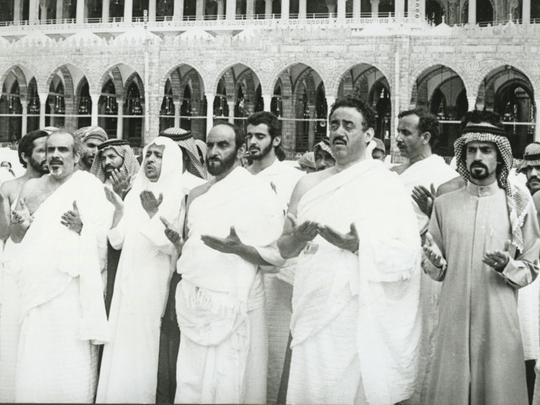
Abu Dhabi: The challenging routes that pilgrims travelled across continents to reach Makkah will be showcased at an upcoming exhibition focused on Haj at Shaikh Zayed Grand Mosque, the event’s organisers said on Wednesday.
‘The Haj: Memories of a Journey’ exhibition will open to the public on September 20 and run until March 19, 2018. Forming the largest part of the exhibition, the ‘Journey Section’ will feature the legacy of the arduous and challenging routes that pilgrims travelled.
The ‘Journey Section’ will also reflect on the late Shaikh Zayed Bin Sultan Al Nahyan’s personal Haj journey, which he made in 1979. Amongst early television news reports that were aired to give updates on the progress of the Haj pilgrims, a rare interview from Abu Dhabi Media Company will be shown in the exhibition, showing Shaikh Zayed discussing the purposes of Haj and addressing political issues of the time from ‘Mina’.
| A photograph from the Imperial War Museum in London shows an Indian pilgrim returning from Makkah in 1941. |
It will also display a very precise historical account of the evolution of the Haj routes from the era of ships, and then on to before the invention of aircraft, when the journey to Makkah used to be undertaken by foot, to the present day, where the most common mode of transport is by air. Among the rare photographs in the exhibition are some from the archives of the renowned late photographer Noor Ali Rashid that go back to the age of steamboats, first used to reach the Holy Land in the mid-20th century, with an image of a ship sinking off the coast of Dubai in 1968 on its way to Pakistan.
Tracing the ancient art of determining routes to Makkah by use of astronomical instruments that located guiding stars and the direction of the Qibla, the exhibition will display original tools from the Zayed National Museum permanent collection, such as the copper astrolabe, invented by Ahmad Bin Mohammad Bin Ebrahim, in Morocco, around the year 1123 AH (1711/1712 AD). Also featured are devices that indicate the direction of the Qibla from the Nasser Daoud Khalili Collection of Islamic Art, dating back to different periods of Islam.
Following the old roads that lead to the holy destination, the exhibition will display maps of routes that pilgrims took across the Arabian Peninsula, and highlight some of the most famous resting points along the way, such as under the ‘Shabhana’ tree, near the small Emirati city of Al Sila, which shares its border with Saudi Arabia. Other maps illustrate the old routes of pilgrims across Africa and Asia, while some show the Hejaz railway network established by the Ottomans at the beginning of the 20th century to connect the major cities to Makkah. A collection of rare pictures and postcards document this monumental railway project, from its beginnings up until the time it was demolished during the course of the Second World War.
Held under the patronage of Shaikh Mansour Bin Zayed Al Nahyan, Deputy Prime Minister and Minister of Presidential Affairs, the exhibition is organised by Shaikh Zayed Grand Mosque Centre (SZGMC), in collaboration with Abu Dhabi Tourism and Culture Authority (TCA Abu Dhabi). The exhibition coincides with the tenth anniversary of the opening of the mosque; the first prayer to take place at the mosque was that of Eid Al Adha in 2007.
| A lacquered wooden lid, showing the direction of the Qibla, from the Nasser D. Khalili Collection of Islamic Art. |
“The mosque is a unique example of Islamic architecture, and it plays a key role in representing the universal values that characterise Islam. The Centre has succeeded in attracting five million visitors every year from across the globe to the mosque and it was named the world’s second favourite landmark by Trip Advisor in 2016,” said Yousif Al Obaidli, Director General of Shaikh Zayed Grand Mosque Centre.
“By shedding light on the fifth pillar of Islam and the importance of Haj, visitors will be able to witness the values of cultural communication that are intrinsic to this practice,” he added.
Saif Saeed Gobash, Director General of TCA Abu Dhabi, said: “The exhibition draws attention to the relationship of our Emirati community with this spiritual journey, something which reflects the key values of our beliefs. The most important of these values are equality, tolerance, humility, good character, forgiveness, charity and loyalty to principles. Shaikh Zayed Bin Sultan Al Nahyan, the late founder of the United Arab Emirates, praised the noble ideals of tolerance, and represented a role model as an Arab Muslim leader who is committed to his religion, homeland and nation. He was an ambassador of Islam to the world.
“The exhibition will highlight the historical narrative of Haj, from the arrival of Islam to this region of the Arabian Peninsula. It will also showcase the innovations Muslims have made towards facilitating the journey and making it more accessible for everyone, along with the traditions that have surfaced and the growing cultural significance that the holy season has developed over time.”
Other notable exhibits include Islamic manuscripts, archival photographs and archaeological finds loaned from a range of local and international institutions, as well as a selection of private collections, personal possessions and Haj memorabilia shared by members of the community.
Visit www.szgmc.ae for more details about the exhibition. For more information, follow the event via the hashtag #HajjExhibition on Twitter and @szgmc_ae on Instagram.











